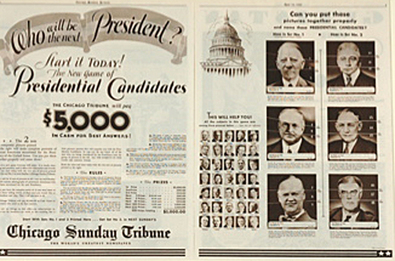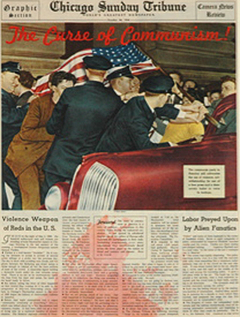|
The Janet A. Ginsburg Chicago Tribune Collection is available for research at Michigan State University Libraries.
|
|
The popular mix-and-match-style contests, which required readers to cut and reassemble pictures in order to win, were a Tribune favorite throughout the 1930s. Other such contests included, Misplaced Faces of Movie Stars, Aces in the Air, and The Men Behind the Flags (Fighting Men of the World Portrayed in a New Game). Clues often required considerable background knowledge.
One of the Tribune’s earliest contests was also inspired by politics. In 1897, reader-contestants for the Mayoralty Competition were asked to draw the face of whom they thought would be the next Mayor of Chicago. Prizes ranged from $10 to $25, split into two categories, one for adults an one for "children under 16," too young to actually vote. On May 4, 1886, a group of laborers gathered at Chicago's Haymarket Square to protest a violent confrontation that had taken place the day before between police and strikers at the McCormick Reaper Works. Six strikers had been shot. The rally was called by the editor of Arbiter-Zeitung, an anarchist newspaper. Although the crowd dwindled from 3,000 to 500 as it began to rain, the police—against Mayor Carter Harrison’s wishes—ordered everyone to leave. Then someone, never officially identified, threw a bomb. The police opened fire and by the time the whole thing was over, a policeman and a civilian were dead and 84 others wounded.
Seven rally organizers were sentenced to death for the officer’s murder. Of the seven, four were hanged, one committed suicide and two had their sentences commuted to life in prison. An eighth defendant was sentenced to 15 years. In 1893, Governor John Peter Altgeld pardoned the prisoners, citing an unfair trial. The Haymarket Riot rocked the country. The Tribune, under editor and publisher Joseph Medill, took a strong anti-labor stance, lumping together anarchists, communists, socialists and the “foreign-born” as rabble-rousing troublemakers. When this article ran in 1938, publisher Robert R. McCormick, Medill’s grandson, was also alarmed by socialists and communists, terms were still often used interchangeably. McCormick believed that President Franklin Roosevelt’s domestic policies were essentially socialist and used the newspaper to rail against the dangers he perceived. |
MAPS, INFOGRAPHICS, CONTESTS, SURREALISM & SONG
Sorting through the old news-pages in my basement workshop, I lived the drama of the past day by day, marveling at the imagination and craft of the illustrations. Maps were a Tribune specialty. The paper even had its own staff cartographer. At first, maps were printed in the lush brown inks of rotogravure. Then “color Roto" came into vogue and the line between information graphic and art began to blur. A 1938 map on A Guide to the Next War in Europe brilliantly illustrated the relative dominance of England, France, Italy, Germany and the Soviet Union over smaller counties through the use of color. For example, Germany was green, the Soviet Union red and Turkey, which lived under threat from both countries, was striped red and green. This was at-a-glance geopolitics. Long before anybody had heard of “interactive media," the Tribune was constantly experimenting with features designed to spark reader participation. In 1929, a map about the U.S. Senate asked readers to weigh in on whether small, insignificant states should have the same number of senators as big, powerful states, such as Illinois; and whether it would be better to have economic regions instead of states altogether. With $3,500 in prize money at stake, readers were asked to submit ideas for redrawing the map of the United States. Some of the Tribune’s ideas were more than a little off the wall, worthy of The Onion or The Daily Show. Yet in utter seriousness, the paper turned presidential politics into an actual game: Who Will Be the Next President? In 1932, readers were provided with a head-shot guide of 35 potential candidates. Each week, for 10 weeks, three different candidates were featured. But their pictures were jumbled in composite photos where each portrait was cut into thirds: forehead, nose, and mouth. Readers were supposed to cut the pictures apart and reassemble them properly based on clues. “The forehead in No.1 is that of the thirty-first President of the United States. The eyes, ears and nose are those of the 1928 Democratic nominee for President. The mouth and chin in No. 3 are those of the thirtieth President.” Readers had to name the candidates and send a letter stating—in 50 words or less—whom they wanted to win and why. “The Chicago Tribune will pay $5,000 in cash for the best answers!”
Even more surreal was an illustration from 1934, Dictators: The Composite Iron Man, which superimposed the faces of eight European despots. Phrenology, the faux science of determining what someone is like based on head shape was in fashion. In a bold faux scientific move, the Tribune took on the heavy responsibility of showing the public what to be on the alert for, dictator-wise. The paper also published Hitler’s horoscope. Other efforts were considerably more charming. The newspaper printed sheet music for songs that readers could practice at home on the piano, then listen to broadcast on WGN radio performed by the WGN orchestra. Most of the songs were romantic fluff. But long-time publisher, Robert R. McCormick, a relentless promoter, couldn’t resist the opportunity to get everyone singing his favorite song: You Have Lots of Time to Read on Sunday. ….We hurry through a busy week At McCormick's personal estate, Cantigny, in suburban Wheaton, the Tribune planted a small "experimental" farm, regularly reporting on how various crops were doing. So bullish was the staunchly Republican publisher on soybeans during the 1930s, he even put aside his deep disdain for Democrats to support Secretary Henry Wallace’s call for soybean research at the University of Illinois.
To a remarkable extent, the newspaper became all things to all people. It was an encyclopedia, tackling subjects from How Much is a Billion Dollars? to Time: The Everlasting Mystery. For those with a taste for the salacious there were stories on Dillinger’s Orgy of Crime (whch included details on a jail break engineered with a bar of soap carved to look like a gun), and Handmaiden of Hell, complete with a text box on the “argot of the dope fiend." POLITICS & WAR When I started, I had hoped to find enough material for a show, but the challenge turned out to be making sense of the bounty. There were thousands of brilliant political cartoons by Pulitzer-winners John T. McCutcheon, Carey Orr, along with Frank King, and the master of social satire, W.E. Hill. There were luscious irresistable color roto ads for bathing suits and cigars and dish detergent. There were incidentals, little gems such as the “crime-o-meter” tucked into long columns of type. And then there were the articles that simply took my breath away, where form and content were so tightly bound together, the art and the message were one. When Liberty Dies by John Dickson, from 1939, was one such example. Before reading a single word, readers immediately knew from the design that the story was about an epic battle between good (the US) and evil (Nazi Germany). Remarkably, despite McCormick’s strong opposition to American involvement in World War II, the article makes the case visually, metaphorically and with point-by-point logic that that only America would be able stand up against Hitler. This was almost two years before Pearl Harbor. There was even more to the story. “John Dickson” never worked a day in his fictitious life for the Chicago Tribune or any other paper. The name— deliberately chosen to be tough, masculine, simple, and oh so American-sounding—was the cover for a petite powerhouse named Sigrid Schultz, the paper’s Berlin bureau chief. Schultz did not set out to become a journalist, but became one of the most respected of her time. Born in Chicago, but raised in Europe, she graduated from the Sorbonne with hopes of becoming an opera singer altogether. In 1914, on the eve of WWI, Schultz and her family were confined to Berlin as enemy aliens. She taught French and English to get by and was eventually hired by the Tribune in 1919 as an interpreter. Schultz worked her way up to reporter, becoming bureau chief in 1925, the first woman ever to head a major European bureau. In the late 1930s, Schultz invented her alter-ego, Dickson, as a ruse to protect her from getting kicked out the country by the Nazis. Of all of her many considerable accomplishments, she was said to be most proud of her scoop of the 1939 Nazi-Soviet non-aggression pact, which led to the invasion of Poland. By 1940, not even John Dickson could save Schultz, who was forced to leave Germany. She spent the next several years writing a book about her experiences, Germany Will Try It Again. After the War, she was among the first journalist to see the Buchenwald concentration camp and covered the Nuremberg trials. THE NEXT PAGE... It is somehow comforting to know that those who came before us were often making it up as they went along, too. History has a way of smoothing over the rough edges that not only give life its texture, but also provide the best, most insightful stories. I am thrilled that the Janet A. Ginsburg Chicago Tribune Collection--a survivor of too many near misses with garbage trucks—has finally found such a good home at Michigan State University. My work was only a beginning. I am so excited to see what others will discover. Old newspapers, it turns out, aren’t just for fishes any more. |
























